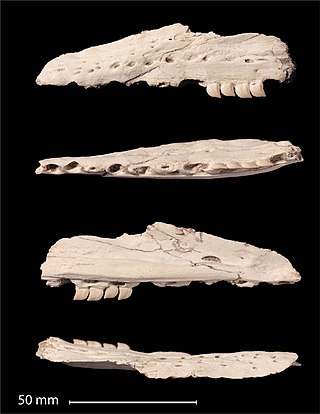Top Qs
Timeline
Chat
Perspective
Xenodens
Extinct genus of lizards From Wikipedia, the free encyclopedia
Remove ads
Xenodens (from Greek and Latin for "strange tooth") is a potentially dubious extinct genus of marine lizard belonging to the mosasaur family. It contains a single species, X. calminechari (From Arabic کالمنشار, meaning "like a saw"), which is known from Late Maastrichtian phosphate deposits in the Ouled Abdoun Basin, Morocco.[1]
Remove ads
Description

Initial estimates suggested the fossil material could belong to an animal with a body length of around 1 meter (3.3 ft).[2] The genus and type species were named for the purported short and flattened blade-like teeth that collectively form a set of saw-like jaws in this taxon. This is a strange feature that had never been seen in any other tetrapod but converge with the jaws of modern dogfish sharks and piranhas. In their 2021 description of this taxon, Longrich et al. hypothesized that these similarities were indicative of a broad diet of cephalopods, crustaceans, fish, and scavenged marine reptiles in Xenodens.[1]
Remove ads
Classification
Xenodens is placed within Mosasaurinae, and its closest known relative is believed to be the durophagous Carinodens.[1] In 2024, Sharpe, Powers & Caldwell reassessed the established holotype of Xenodens and argued that it represents a chimeric forged fossil. Their review suggested that the four teeth preserved in the specimen had been artificially added over two alveoli in the maxilla. The unusual morphology of the preserved teeth may result from intraspecific variation, as tooth shape can vary through ontogeny, so the possibility that the taxon represents an immature Carinodens cannot be precluded. As such, they interpreted the taxon as a nomen dubium in need of more detailed research based on CT scans to determine if the specimen is authentic.[3][4] Moreover, Sharpe et al. criticised an insufficient degree of diligence in how Longrich et al. had treated the type material which local miners had extracted during an unsupervised commercial excavation.[3] Doubts have also been raised concerning the provenance of the type material as it is uncertain whether it was collected with a permit as required by Article 116 of the Moroccan Mining Code.[5]
Remove ads
External links
- This ancient sea reptile had a slicing bite like no other, Xenodens calminechari, with life-restoration. Science News, February 2, 2021
- Xenodens, a weird shark-toothed mosasaur from Morocco- Nick Longrich
References
Wikiwand - on
Seamless Wikipedia browsing. On steroids.
Remove ads

